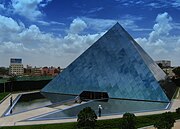
I have two thoughts, and am too lazy to write two separate posts so I clubbed them into one.
Al-Google:
Google is funny, really. I was just taking a trip down ego-boosting lane, and did a Google search for myself, and found that searching for "Shashank Shekhar" (which sadly appears to be quite a common name nowadays) returned a reference to Me first on #15, and my current blog at #17 and my old blog at #20. Then, I did a search for just "Shashank", and Hey Presto! I jumped to #7! I thought adding descriptive keywords narrowed searches!
(PS: Yeah yeah, before you SEO geeks start giving me the reasons, the reason is that the #7 position is occupied by my old blog which is called just "Shashank's Blog", with no mention of Shekhar, so..)
My second topic is entitled: "Silicon Valley of India: A Miracle"
Well, I was reading a nice article about the coming together of the original Silicon valley, a paper actually, (here) and I agree with his explantion that the Silicon Valley came together because of a rare co-occurrence of a lot of events that catalysed such an event. The Venture Capitalists were there, the Infrastructure was there, the Research places and great Universities were there, all mostly in the same San Francisco Bay Area in Northern California. The setting was just right for something amazing to suddenly come up. The university people came up with great ideas, the area had sufficiently high academic cultured people living around to encourage such innovation and if someone felt that some money could be made out of those ideas, the venture capitalists were there to be sold to the ideas. The spirit of risk-taking was enhanced by some early successes and the smell of money being generated. And people had garages which could be used as offices, and small rooms could be rented for the same purpose too. And employees had places to stay nearby and basic infrastructure like roads and transport pre-existing due to the existence of older residential areas in the neighbourhood. Yes, this is an over-simplification, but these points will come into play in my next paragraph.
Now how Bangalore came to become the Silicon Valley of India is indeed a puzzling thought. Lets see, Bangalore did have residential areas pre-existing, but I think that really was IT (no pun intended). No great Venture Capitalists prowling around, miserably tiny roads and basic small-town transport facilities, and most of all, no Stanford-like great Universities in the neighbourhood to fuel ideas. Therefore how the great start-ups of Bangalore came up, attracted investors, got clients, performed their day-to-day activities with the miserably lacking infrastructure is something that is nothing short of a Miracle. Even today, companies have their own internal power generators as depending on Bangalore City's own rickety power supply would effectively lose them deals worth millions of dollars everyday, they need to find ways to work around the terrible chaos existing in the cramped roads of a city that just grew too fast. Oh and when it rains (which it does for 3 hours every evening), the city halts to a standstill as it is impossible to drive with the pot-holes, broken roads and impossible to work with the power-cuts. I'm still wondering how this Miracle came about. The only possible explanation I see is that
a) The people who started the first start-ups were incredibly clever at attracting investors,
b) The Indians are willing to slave for really long hours with considerably lesser pay (which is true). Hence India is the hot-destination for a cheap-workforce, hence a great deal of investment in off-shore development.
PS: The building in the picture is the Infosys Headquarters.
PPS: If you're interested in reading some interesting stuff related to Silicon Valley, check out some interesting SV blogs I follow as often as I can spare time:
- Silicon Valley Technology & Corporate updates
- Good morning Silicon Valley -- some pretty interesting reads about some really dumb as well as really good stuff happening there. :-)











